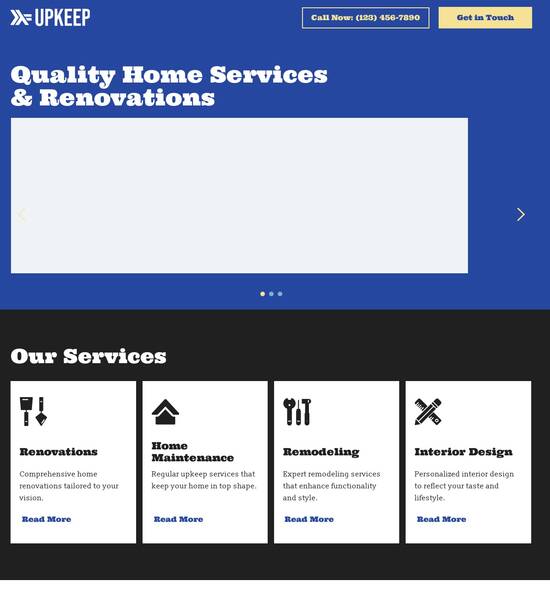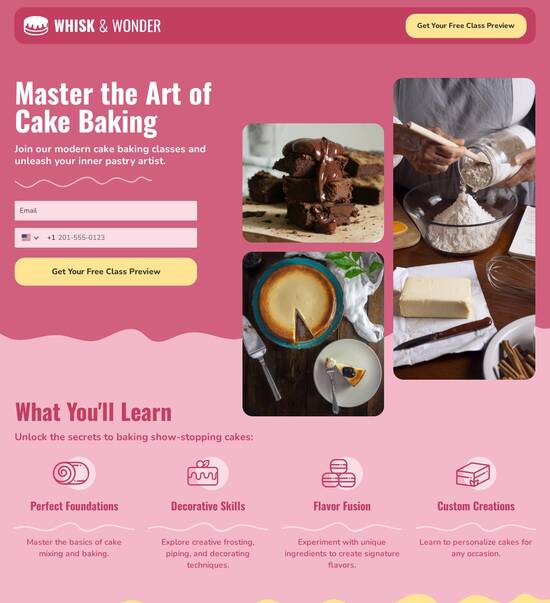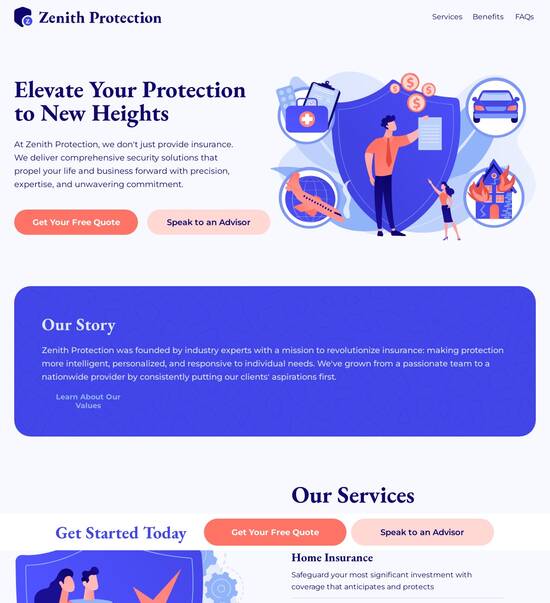
HTML page template for Robotics engineers
Use TemplateAbout template
Attract clients and showcase your skills with style using our landing page templates for Robotics engineers. Let's convert those visitors into clients!
Recommended templates

Easy to build without coding
With the intuitive drag-and-drop builder, anyone on your team can create high-converting pages without any knowledge of code or design. Make enhancements to your landing page with custom widgets using Javascript, HTML/CSS, or third-party scripts.

Multiple layouts for any industry and goal
Select from 500+ landing page layouts built to boost conversions across industry-specific scenarios. Customize them by adjusting fonts, adding images, and generating on-brand content with the AI assistant. Quickly scale with Instablocks® and Global Blocks that you can save, reuse, and update globally.

Loads fast and looks polished on any device
Every template is responsive, which means they present professionally on any device and load blazingly fast with our Thor Render Engine. You can also power them up with Google AMP technology to deliver an unparalleled mobile experience and drive higher conversions.

Robust analytics & experimentation
Get real-time updates and reporting across all your devices, showing the number of visitors, conversions, cost-per-visitor, and cost-per-lead. Launch AI-powered experiments, run A/B tests, and use heatmaps to analyze user behavior, then optimize your landing page to maximize conversions.







Easy to build without coding
With the intuitive drag-and-drop builder, anyone on your team can create high-converting pages without any knowledge of code or design. Make enhancements to your landing page with custom widgets using Javascript, HTML/CSS, or third-party scripts.
Multiple layouts for any industry and goal
Select from 500+ landing page layouts built to boost conversions across industry-specific scenarios. Customize them by adjusting fonts, adding images, and generating on-brand content with the AI assistant. Quickly scale with Instablocks® and Global Blocks that you can save, reuse, and update globally.
Loads fast and looks polished on any device
Every template is responsive, which means they present professionally on any device and load blazingly fast with our Thor Render Engine.
Robust analytics & experimentation
Get real-time updates and reporting across all your devices, showing the number of visitors, conversions, cost-per-visitor, and cost-per-lead. Launch AI-powered experiments, run A/B tests, and use heatmaps to analyze user behavior, then optimize your landing page to maximize conversions.
All the features you need to build lead-generating landing pages
Explore more featuresLearn how to build top-performing landing pages for any goal
FAQs
Leading the way in building high-performing landing pages





A powerful guide to using Instapage for landing page optimization
Instapage is the most powerful landing page and CRO platform designed for marketers who want to excel in optimizing their campaigns and maximizing ROI. With an all-in-one solution for landing page creation and conversion rate optimization (CRO), Instapage provides businesses across various sectors — from tech to education — with the necessary tools to enhance their digital marketing efforts. This guide will walk you through essential steps for leveraging Instapage effectively.
Step 1: Choosing the right landing page template
Selecting an appropriate template is crucial for achieving higher conversion rates. Instapage offers over 100 high-converting templates, which cater to different industries and campaign goals. By using these templates, you can save time while still creating visually appealing and functional landing pages.
- Choose templates tailored to your industry: Templates designed specifically for sectors like education or tech can enhance relevance and appeal.
- Consider your campaign goals: Select a template that aligns with your objectives, such as lead generation or product promotion.
- Utilize templates that incorporate lead-gen elements: Using pre-built elements saves time and increases effectiveness in capturing leads.
Step 2: Optimizing for conversions through experimentation
Optimization is key to improving your conversion rates. With Instapage’s built-in experimentation features, optimizing landing pages becomes a streamlined process. Start by utilizing detailed heatmaps to assess user interactions.
Step 3: Personalizing your landing pages for audience engagement
To maximize the effectiveness of your landing pages, delivering personalized experiences to your unique audiences is essential. Instapage offers dynamic text replacement, allowing you to align specific ads to unique pages through AdMaps. This increases engagement and helps in tracking metrics at the audience level.
- Use dynamic text replacement for tailored messaging: This can significantly enhance user engagement by presenting them with relevant content.
- Align ads to landing pages: Utilizing AdMaps ensures that the content prospects see is directly relatable to the ads they clicked, which reduces bounce rates.
- Track audience metrics: Gathering detailed analytics allows you to iterate and improve upon your strategies effectively.
At every stage, collaboration is essential for creating and refining landing pages. Instapage empowers teams by streamlining feedback and edits, allowing for real-time collaboration that speeds up production.
Embracing Instapage allows for a highly effective landing page creation experience that can transform your marketing strategy and amplify your results. If you're ready to elevate your digital marketing campaigns, consider leveraging Instapage to its fullest potential.
Start your journey to enhanced marketing efficiency today. Create an account on Instapage and unlock the powerful tools that can propel your campaigns forward.
Unveiling the power of HTML page templates in robotics engineering
The intersection of robotics and web development
Robotics engineering encompasses a broad range of disciplines involving the design, construction, operation, and use of robots. This vital field combines concepts from mechanical engineering, electrical engineering, and computer science to create machines capable of performing tasks autonomously or collaboratively with humans. With applications spanning from manufacturing to healthcare, the versatility of robotics is undeniable.
In an era where digital interaction is paramount, having a robust online presence is crucial for robotics professionals. Displaying one's work and achievements on a personal website not only enhances professional visibility but also attracts potential collaborators, employers, and clients. An effective online portfolio can serve as a dynamic interactive resume, showcasing the unique skills and projects that set a robotics engineer apart.
HTML templates play a pivotal role in this digital landscape, facilitating the presentation of robotics projects in a visually appealing and organized manner. By utilizing templates, engineers can efficiently create web pages that emphasize their technical capabilities and achievements, making it easier for users to navigate and understand their expertise.
Crafting the perfect HTML template for robotics engineers
Creating an HTML template tailored for robotics engineers requires a thoughtful approach to design and functionality. Firstly, essential elements should include a well-crafted header featuring the engineer's logo along with intuitive navigation and a catchy tagline. This establishes immediate brand recognition and directs visitors to key sections of the site.
A showcase section is equally important, where highlighted projects and achievements can be displayed prominently. This section not only demonstrates technical prowess but also engages visitors with visual and descriptive content. Displaying technical skills is another vital aspect; a dedicated area showcasing proficiencies and tools used is beneficial for potential collaborators seeking specific expertise.
Header: Including logo, navigation, and tagline.
Showcase section: Highlighting projects and achievements.
Technical skills: Displaying proficiencies and tools.
Blog/news section: Sharing insights and innovations.
Contact information: Building networking opportunities.
Beyond structural elements, ensuring responsive design is crucial. Templates must be compatible across various devices, addressing the increasing trend of mobile and tablet usage. Moreover, visual aesthetics need careful consideration; selecting colors, fonts, and layouts that reflect the themes of robotics will create a cohesive and appealing user experience.
Leveraging JavaScript to enhance user experience
To enrich user engagement, JavaScript can be seamlessly integrated into HTML templates for robotics engineers. By utilizing `document.addEventListener`, engineers can set up event listeners that allow for interactive interfaces. For instance, interactive buttons can trigger animations or showcase specific projects when clicked, enhancing the overall dynamism of the site.
Dynamic content loading is another powerful feature. By employing AJAX, engineers can fetch real-time robotics data, which keeps the website content fresh and up to date. This feature not only improves user experience but also invites visitors to explore more through interactive charts and graphs illustrating relevant data about robotics methodologies or current advancements in the field.
Optimizing loading times and performance
Fast-loading pages are essential in any online platform, and this is particularly true for robotics engineering websites. Users often seek quick access to information, and delays can result in high bounce rates. By understanding and utilizing `DOMContentLoaded`, website developers gain insight into the event lifecycle, allowing them to optimize scripts for improved loading times.
Case studies show a marked improvement in user retention on pages optimized for speed versus those that are not. Simple best practices can assist in achieving this, such as minimizing JavaScript and CSS files, using efficient coding techniques, and implementing caching strategies to ensure content is quickly accessible.
Integrating multimedia elements in robotics projects
Adding multimedia elements can greatly enhance a robotics engineer's web presence. Visuals in the form of images and videos not only engage visitors more effectively but also convey complex information succinctly. Incorporating videos from robotics competitions or demonstrations can provide a direct glimpse into an engineer's capabilities and innovations.
Additionally, creating interactive demos using Canvas and SVG can showcase robotics mechanisms visually. These elements allow users to engage with the technology at a deeper level, enabling them to see and understand the intricacies of the projects involved, thereby enhancing user experience.
Ensuring accessibility in robotics HTML templates
Web accessibility is crucial, ensuring that all users, including those with disabilities, can access online content. For robotics engineers, implementing ARIA (Accessible Rich Internet Applications) standards can provide critical support in this endeavor. Adhering to these guidelines not only promotes inclusivity but also enhances user interaction with website features.
Key practices include using descriptive alt attributes for images, ensuring keyboard navigability, and implementing color contrasts that are easily readable. By prioritizing accessibility, engineers can reach a broader audience and foster a more inclusive community within the robotics field.
Search engine optimization for robotics engineers
SEO is a vital facet of web development that ensures a website's visibility on search engines. Crafting SEO-friendly HTML structures allows robotics engineers to rank higher in search results, leading to increased traffic and engagement. Integrating meta tags and descriptions optimally is key; these elements provide search engines with essential information about the webpage.
Utilizing schema markup tailored to robotics projects can also enhance search results significantly. This method provides search engines with context about the content on the page, leading to rich snippets that are more visually compelling and informative, attracting more clicks from prospective clients or collaborators.
Case studies: Successful HTML templates in action
Examining the online presence of prominent robotics engineers offers insight into successful HTML template strategies. Profiles of these professionals reveal common features, such as user-friendly layouts, rich multimedia content, and clear call-to-actions, which contribute to their impactful web presence.
By analyzing effective HTML template features across various robotics domains, several lessons can be drawn. Emphasizing project showcases and maintaining an engaging blog that shares industry insights are tactics that support continuous visitor engagement and establish authority within the field.
The future of HTML templates in robotics engineering
As technology evolves, so do the tools and techniques used in web development for robotics professionals. Emerging trends are beginning to integrate artificial intelligence and machine learning into web templates, allowing for personalized user experiences that adapt dynamically based on visitor behavior and preferences.
These advancements point toward a future where web interfaces may predict user needs, presenting relevant robotics projects or articles based on individual interests. Such innovations could significantly enhance user experience and engagement, paving the way for broader applications within the robotics community.
Practical implementation: Step-by-step guide to creating a custom HTML template
Planning your template begins with gathering requirements and setting clear objectives. Engineers should define the purpose of their website and the key features they wish to include, ensuring that their vision aligns with their personal brand and professional goals.
Understanding the coding basics of HTML structure is fundamental. Step one involves setting up the document structure, including essential tags like '' and ''. The next step focuses on building the header and footer, which will contain the navigation links and copyright information respectively.
Then, engineers must create the main sections utilizing CSS for styling. This is where individual flair comes into play, allowing for a unique look that represents one's work. Adding interaction with JavaScript, implementing 'document.addEventListener' for triggering responses to user actions, creates a dynamic and engaging environment.
Collaborative tools and resources for robotics engineers
In the collaborative world of robotics engineering, utilizing the right tools can streamline project development and template sharing. Platforms designed for team collaboration, such as GitHub or GitLab, encourage teamwork by allowing multiple users to work on templates simultaneously and maintain version control.
Additionally, exploring open-source libraries and frameworks such as Bootstrap or jQuery can drastically reduce development time and streamline the process of building comprehensive HTML templates. Engaging with online communities, including forums or social media groups focused on robotics, serves as an excellent resource for gaining insights, feedback, and support from fellow professionals.
Measuring template success: Analytics and feedback
Understanding how visitors interact with a robotics engineering website is paramount for continuous improvement. Gathering user feedback provides invaluable insights that can be leveraged to refine templates and enhance user satisfaction. Survey tools or direct feedback forms can capture visitor thoughts, helping identify areas for improvement.
Performance tracking tools, such as Google Analytics, offer in-depth data regarding site traffic and user engagement. These insights assist engineers in assessing what content resonates most with visitors, enabling data-driven decisions for future updates. Additionally, employing A/B testing can help optimize web presence, allowing for comparisons between different designs or features to maximize effectiveness.
Ready to skyrocket conversions?
Supercharge your ad campaigns with high-performing landing pages
Get started














